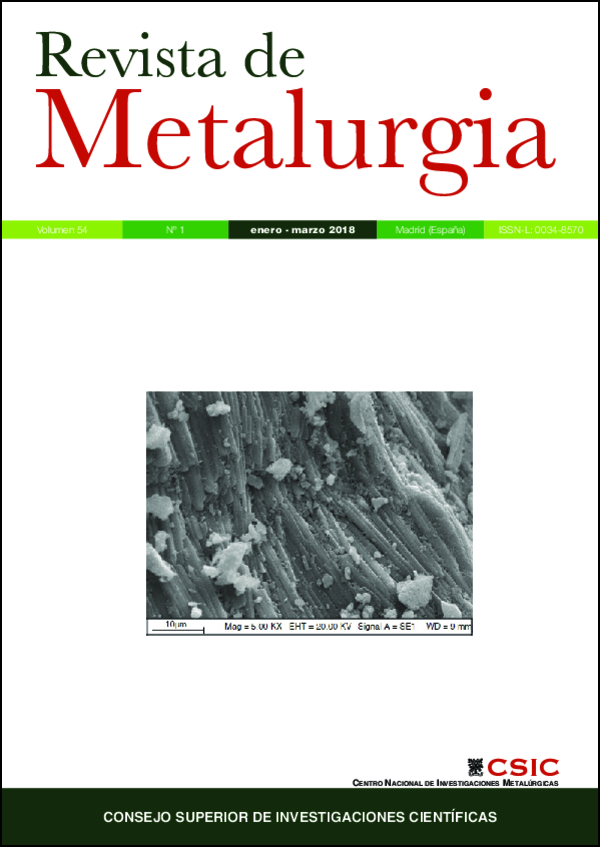Aplicación del ajuste de Rietveld para correlacionar la evolución microestructural de fundiciones blancas con 18 y 25% en Cromo, templadas en aceite y sucesivos revenidos, con el comportamiento frente al desgaste abrasivo y esfuerzos de flexión
DOI:
https://doi.org/10.3989/revmetalm.113Palabras clave:
Carburos secundarios, Desgaste abrasivo, Difracción de Rayos X, Fundición blanca altamente aleada en Cr, Método de Rietveld, Resistencia a flexiónResumen
Mediante la aplicación del método de afinamiento estructural de Rietveld se identificaron y cuantificaron las fases presentes en fundiciones blancas hipoeutécticas con 18 y 25% en Cromo, templadas en aceite y tras sucesivos revenidos a 500 ºC. Se correlacionaron los resultados con su comportamiento frente al desgaste abrasivo y bajo esfuerzos de flexión. En ambos casos el porcentaje de austenita retenida tras el temple resultó mínima. Durante los sucesivos revenidos, se constató en la calidad con 18% en Cromo una redisolución parcial de los carburos M7C3 junto a una transformación entre carburos mixtos secundarios M7C3 y M2C. La Martensita tras temple resultó un factor clave frente a la resistencia al desgaste abrasivo, resultando los revenidos tras el temple en aceite desfavorables para esta propiedad. La calidad con 25% en Cromo fue la que presentó un mayor contenido en martensita tras el temple, y por tanto la que mejor comportamiento presentó frente a este tipo de desgaste. Esta misma calidad, tras el doble revenido, fue la que mayor resistencia y capacidad de deformación alcanzó bajo esfuerzos a flexión. La fractura resultó frágil y mayoritariamente transgranular. Sin embargo, pudo observarse la presencia de zonas con fractura dúctil asociadas a martensita doblemente revenida.
Descargas
Citas
ASTM G76 (2004). Standard Test Method for Conducting Erosion Tests by Solid Particle Impingement Using Gas Jets. ASTM International, West Conshohocken, PA, USA.
Bedolla-Jacuinde, A., Guerra, F.V., Mejía, I., Zuno-Silva, J., Maldonado, C. (2016). Boron effect on precipitation of secondary carbides during destabilization of high chromium white iron. Int. J. Cast. Metal. Res. 29 (1–2), 55–61. https://doi.org/10.1080/13640461.2016.1142236
Davis, J.R. (1994). ASM Specialty Handbook - Cast Irons. ASM International, Kinsman Road, Ohio, USA.
Efremenko, V., Shimizu, K., Chabak, Y. (2013). Effect of Destabilizing Heat Treatment on Solid-State Phase Transformation in High-Chromium Cast Irons. Metall. Mater. Trans. A. 44 (12), 5434–5446. https://doi.org/10.1007/s11661-013-1890-9
Fairhust, W., Rohrig, K. (1974). Abrasion resistant high chromium cast irons. Foundry Trade Journal 136, 685–698.
Fernández, I., Belzunce, F.J. (2006). Influencia de diversos tratamientos térmicos en la microestructura de una fundición blanca con alto contenido en cromo. Rev. Metal. 42 (4), 279–286.
Gasan, H., Ertuk, F. (2013). Effects of a destabilization heat treatment on the microstructure and abrasive wear behavior of high chromium white cast iron investigated using different characterization techniques. Metall. Mater. Trans. A. 44 (11), 4993–5005. https://doi.org/10.1007/s11661-013-1851-3
Hou, Q.Y., Huang, Z.Y., Wang, J.T. (2009). Application of rietveld refinement to investigate the high chromium white cast iron austempered at different temperatures. J. Iron Steel Res. Int. 16 (4), 33–38. https://doi.org/10.1016/S1006-706X(09)60057-1
Inthidech, S., Sricharoenchai, P., Matsubara, Y. (2012). Effect of molybdenum content on subcritical heat treatment behaviour of hypoeutectic 16 and 26 wt-% chromium cast irons. Int. J. Cast. Metal. Res. 25 (5), 257–263. https://doi.org/10.1179/1743133612Y.0000000009
Opapaiboon, J., Sricharoenchai, P., Inthidech, S., Matsubara, Y. (2015). Effect of carbon content on heat treatment behavior of multi-alloyed white cast iron for abrasive wear resistance. Mater. Trans. 56 (5), 720–725. https://doi.org/10.2320/matertrans.M2015001
Pero-Sanz, J.A. (1994). Materiales para Ingeniería. Fundiciones Férreas. Editor Dossat, Madrid.
Powell, G.L.F., Bee, J.V. (1996). Secondary carbide precipitation in an 18 wt% Cr-1 wt% Mo white iron. J. Mater. Sci. 31 (3), 707–711. https://doi.org/10.1007/BF00367889
Scandian, C., Boher, C., de Mello, J.D.B., Rezai-Aria, F. (2009). Effect of molybdenum and chromium contents in sliding wear of high-chromium white cast iron: The relationship between microstructure and wear. Wear 267 (1–4), 401–408. https://doi.org/10.1016/j.wear.2008.12.095
Tenorio, J.A.S., Albertin, E., Espinosa, D.C.R. (2000). Effects of Mo additions on the solidification of high chromium cast iron. Int. J. Cast. Metal. Res. 13 (2), 99–105. https://doi.org/10.1080/13640461.2000.11819393
Wang, J., Zuo, R.L., Sun, Z.P., Li, C., Liu, H.H., Yang, H.S., Shen, B.L., Huang, S.J. (2005). Influence of secondary carbides precipitation and transformation on hardening behavior of a 15 Cr-1 Mo-1.5V white iron. Mater. Charact. 55 (3), 234–240. https://doi.org/10.1016/j.matchar.2005.06.002
Wang, J., Sun, Z., Shen, B., Gao, S., Zuo, R., Li, C., Huang, S. (2006). Effects of secondary carbide precipitation and transformation on abrasion resistance of the 16Cr-1Mo-1Cu white iron. J. Mater. Eng. Perform. 15 (3), 316–319. https://doi.org/10.1361/105994906X108602
Wiengmoon, A., Pearce, J.T.H., Chairuangsri, T. (2011). Relationship between microstructure, hardness and corrosión resistance in 20 wt.%Cr, 27 wt.%Cr and 36 wt.%Cr high chromium cast irons. Mater. Chem. Phys. 125 (3), 739–748. https://doi.org/10.1016/j.matchemphys.2010.09.064
Publicado
Cómo citar
Número
Sección
Licencia
Derechos de autor 2018 Consejo Superior de Investigaciones Científicas (CSIC)

Esta obra está bajo una licencia internacional Creative Commons Atribución 4.0.
© CSIC. Los originales publicados en las ediciones impresa y electrónica de esta Revista son propiedad del Consejo Superior de Investigaciones Científicas, siendo necesario citar la procedencia en cualquier reproducción parcial o total.
Salvo indicación contraria, todos los contenidos de la edición electrónica se distribuyen bajo una licencia de uso y distribución “Creative Commons Reconocimiento 4.0 Internacional ” (CC BY 4.0). Consulte la versión informativa y el texto legal de la licencia. Esta circunstancia ha de hacerse constar expresamente de esta forma cuando sea necesario.
No se autoriza el depósito en repositorios, páginas web personales o similares de cualquier otra versión distinta a la publicada por el editor.
















